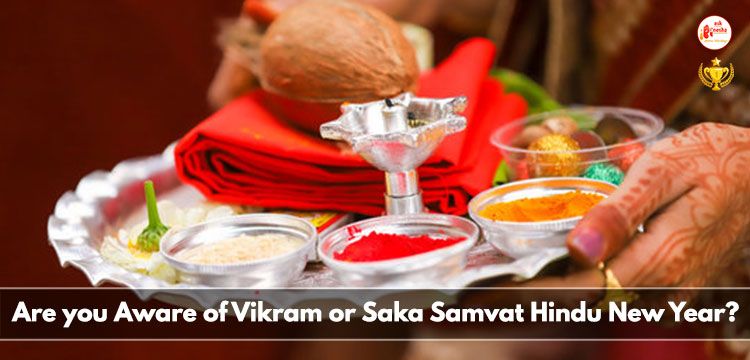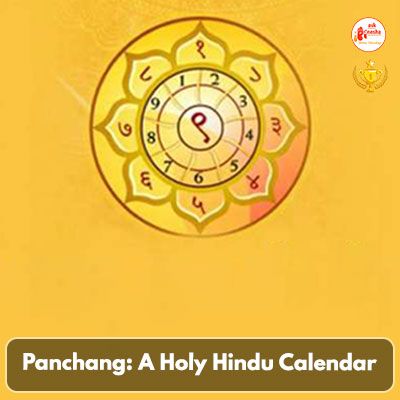The English or Gregorian calendar is the most common calendar used throughout the world. January is the first month as per the Gregorian calendar. However, across India, the Hindu New year is celebrated as per the Vikram and Saka Samvat calendar. Based on these calendars it usually falls in the March-April month. Here 'Samvat' or Samvatsara is the Sanskrit term that means year in Vedic literature. Vikram Samvat and Saka Samvat are the two commonly used calendars in India. They are mainly followed for religious events, puja, fasting, and sowing & harvesting agricultural seasons.
When did Vikram or Saka Samvat start?
Vikram Samvat started during King Vikramaditya's era. Named after Vikramaditya's victory over the Sakas in 57 BC and also to mark his inspirational achievements in royal affairs, religion and justice. On the other hand, Saka Samvat started in the era of 78 AD, after king Shalivahana of the Satavahana dynasty defeated Sakas, but there is not much historical evidence. Therefore, each Samvatsara or Samvat derives its name from the legends that evolved in the history timeline. The name also marks a tribute to some magnificent personalities. For instance Lord Krishna Samvatsara, Kali Samvatsara, Lord Budhdha Samvatsara, Hijri Zsamvatsara, Fasli Samvatsara, Nankshahi Samvatsara and so many others.
Vikram Samvat
The Vikram Samvat is 56.7years ahead of the Gregorian calendar except for Jan to April when it is ahead by 56 years. After adding the total sum of 57 years to the current Gregorian year you get Vikrama Samvat Hindu calendar year. So currently, we are in Vikram Samvat 2079 vs. Gregorian 2022 year. It uses Lunar months and Solar sidereal years for the calculation of dates and months. It is also the official calendar of Nepal. Unlike the Gregorian calendar, it has 354 days in a year and 12 months.
Saka Samvat
If we look at the Saka Samvat, it is 78 years behind the Gregorian year which means currently the Saka Samvat year is 1944. In 1957 Saka Samvat was accepted as India's National civil calendar by the Government of India. However, the government made a few changes in Saka Samvat in 1957. It is also used by the Indonesian Hindus in Bali and Java. Saka is largely followed in Southern India and Maharashtra. Similar to the Gregorian calendar, the Saka Samvat consists of 365 days and 12 months, but the first month is Chaitra. Which begins on March 22 and March 21 during the leap year.
The Names of 12 months in Vikram Samvat and Saka Samvat are the same, both have Shukla Paksha and Krishna Paksha. The only difference is at the beginning of the month.
Shukla Paksha (15 days) begins with the new moon and ends with a full moon
Krishna Paksha (15 days) Starts with the full moon and ends with the new moon
Chaitra, Vaisakha, Jyaishtha, Ashadha, Sravana, Bhadra, Asvina, Kartika, Agrahayana, Margasirsha, Pausha, Magha, Phalguna. In the Vikram Samvat the new month starts with the Krishna Paksha (Amavas/ Dark Half) which comes after the full moon, whereas in the Saka Samvat the new month begins with the Shukla Paksha (Poornima/Light half) which comes after the new moon.
The Hindu New year in 2022 according to Vikram Samvat was on April 2, whereas based on Saka Samvat it was on March 22 of 2022. Almost all the Hindu New Year festivals start at the beginning of the spring months when nature blossoms and blesses the earth with fresh harvests. And not to forget it's the beginning of a new agricultural cycle. The Hindu New year is celebrated in different states of India by different names and with some variations in the date of celebration.
Baisakhi
It is the biggest harvest festival in Northern India and particularly in Punjab. It falls on the first day of the month of Vaisakh which is April 13 or 14 every year. Besides harvesting, the Sikh community of Punjab celebrates this day to commemorate the formation of the Khalsa Panth of warriors.
Jur Sital
It is Maithili New Year celebrated by the Maithilis in Bihar, Jharkhand and Nepal. It is usually celebrated on April 14 or 15, according to the Gregorian calendar.
Bohag Bihu
Also known as Rangali Bihu, Bohag Bihu is similar to Baisakhi it is celebrated for the new harvest in Assam with lots of sweets shared amongst the family and friends. Bohag Bihu is celebrated for three days continuously with many different traditions being followed.
Gudi Padwa
Gudi Padwa is the New year of Maharashtra. They follow dates as per the Marathi Saka Samvat calendar for the Gudi Padwa festival. It usually falls between March and April. Harvesting season is the main reason for celebration. But the day also symbolises the victory of Chatrapati Shivaji Maharaj over his enemies and Shalivahans victory over the Sakas in 78 AD. Maharashtrians.
Ugadi
Ugadi or Yugadi is the New Year celebration of Andhra Pradesh, Telangana and Karnataka. Both Ugadi and Gudi Padwa are celebrated on the same day which is on the first day of the Hindu lunisolar calendar month of Chaitra. Ugadi also follows the Saka Samvata calendar. In Northern India, although Ugadi and Gudi padwa are not celebrated but interestingly on the same day Chaitra Navratri puja starts.
Bestu Varas
It is the Gujarati New year also known as Varsha Pratipada. Gujarati New year falls on Shukla Paksha Pratipada of the Kartik month. Kartik is the first month of the Gujarati calendar. They prepare new books to keep accounts called the Chopda and worship Goddess Laxmi. Contrary to the other regions it is related to traders and businessmen not to the harvesting season.
Vishu
Vishu festival again is another celebration that marks the beginning of harvest in Kerala region. It is also celebrated in Mangalore, Udupi district in Karnataka, Mahe district of Pondicherry and some areas of Tamil Nadu. Every year it comes on April 14 or 15 as it follows the Malayalam calendar or Kollam era. It is a Solar Calendar used in Kerala dated back to 825CE. There are celebrations even at Sabarimala Ayyappan Temple and Guruvayur Krishna temple.
Pohela Boishakh
Another state that celebrates a different style of New Year is West Bengal. The Poila Boishakh is the first day of the Vaisakh according to the Bengali Solar calendar. It also falls on April 14 or 15 each year. There are a lot of cultural celebrations all over the state. Incidentally, most of these new year festival dates are close to each other. Although, the names and ways of celebration are unique. Mainly the celebration is for the harvest season and the beginning of the new agricultural cycle. The regions may refer to their own traditional calendar but the Vikram Samvat and Saki Samvat remain the base of the Hindu Calendar.
























 Translate
Translate